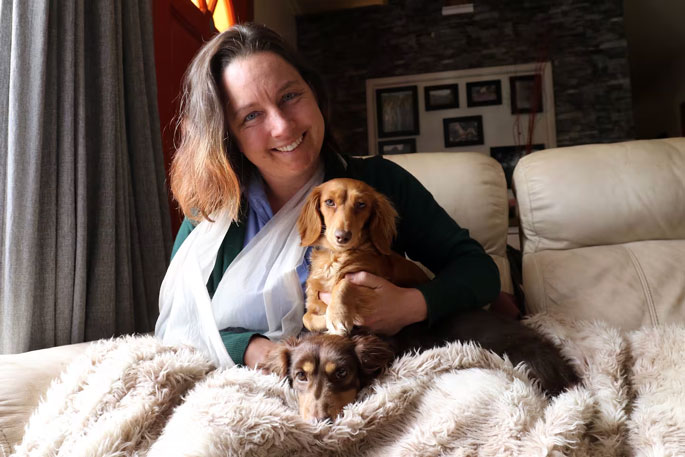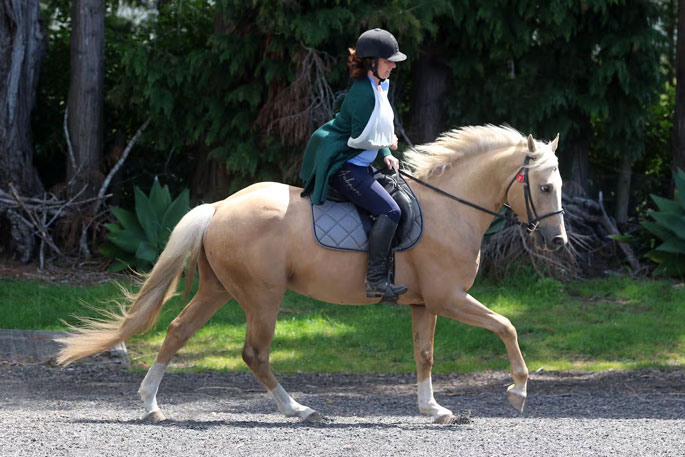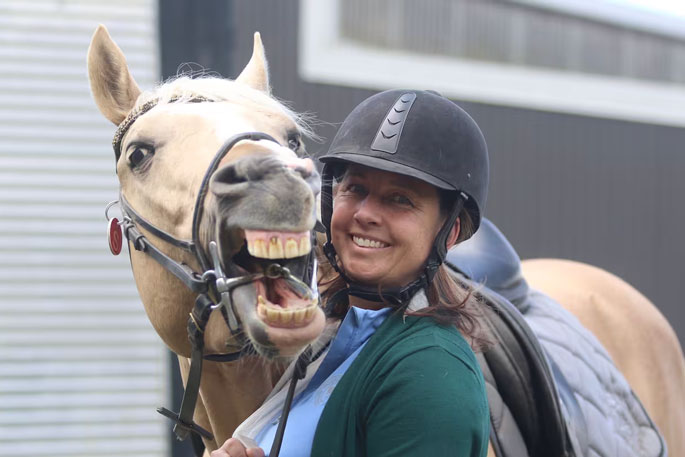“I don’t want a good day to be, maybe I can get on a horse, I want to compete again, I want to jump again.”
Hayley-Grace Davis is well known in equestrian circles locally as a horse breeder and trainer, a riding tutor and a competitor and is the driving force behind Wake Field Equestrian Estate on Te Matai Rd, Te Puke, which she runs with the help of Sophie Thomson and her parents.
After a lifetime of inexplicable, yet debilitating injuries, earlier this year she was diagnosed with Ehlers-Danlos Syndrome (EDS).
EDS is a group of genetically inherited connective tissue disorders typically characterised by bendy joints, stretchy skin and fragile tissue.
It’s a simple description of something that is life-defining.
Because tissue is weak, there is a tendency towards significant injuries from everyday activities.
Over the years, frustration has grown, as has a list of ACC claims that Hayley-Grace says illustrated that something was very wrong.
“It’s severely under diagnosed, and I felt I was being gaslit, but to be fair, doctors don’t know what it is,” she says.
Rather than identify a pattern, she says each injury was viewed in isolation.
“When I saw them with a twisted ankle or bruises, they just take it as that particular injury, they don’t look at my ACC record and there’s thousands of claims. I get seriously injured by doing practically nothing.
 Hayley-Grace Davis has Ehlers-Danlos Syndrome, but has been able to get back on horseback after being hardly able to move for several months.
Hayley-Grace Davis has Ehlers-Danlos Syndrome, but has been able to get back on horseback after being hardly able to move for several months.
“My bones are fine though. The first thing they do is an X-ray - but that’s (bones) the only thing with my body that’s fine. It’s all the soft tissue, the stuff holding it together [that is the problem], so X-rays always look fine.”
She has many instances of the seemingly innocuous causing painful injuries. Two years ago she damaged her ankle.
“I didn’t even slip - I just walked on uneven ground and got this shooting pain. I couldn’t even touch (put) my toes on the ground.”
About six months later all the ligaments around her ankle were torn, with one ripped off entirely.
“Then I did my Achilles tendon - that was just from walking.”
But these are just a small number of examples of an extensive catalogue of injuries that include shoulder injuries, multiple rib dislocations, and injuries to knees and elbows.
“I had funny noises coming from my jaw ... I was actually dislocating it. That’s how much you get used to pain. It becomes a feeling, rather than painful.”
Then there are injuries that come from injuries.
“My knee gave in and I was holding soup and ended up with burns because my knee just gave way without warning.”
She has run the equestrian centre while at the same time being almost constantly injured.
“You are just used to it, so you don’t react the same way.”
Believing there was a serious underlying problem, but feeling she wasn’t being heard was a huge source of frustration.
“When you initially do an injury you feel like you need to exaggerate how you got it because no one is going to believe you - I think that’s the worst part of it - you are just not taken seriously.”
Hayley-Grace also believes that, because of her physical lifestyle, and strong, developed muscles, she was able to keep going.
“Your muscles have to be so much stronger to do the job your ligaments and tendons are not doing. That’s what happens when you are a physical person and horse riding and we’ve found out that has been keeping my body together.
 Hayley-Grace Davis riding Wake Field Peach Schnapps.
Hayley-Grace Davis riding Wake Field Peach Schnapps.
Less activity during the pandemic, and possibly age, conspired to bring things to a head.
“Covid happened and I stopped competing. It takes a year or so to lose the body mass, the muscle.
“I was always injured for some reason, but they got worse and more often. I had to start sleeping with a neck brace and two wrist guards because I was waking up with sprained ankles and a sprained neck.
“That’s when my dad was going, ‘there’s got to be something else here, this doesn’t make sense, no one keeps having this happen to them’.
In the end, she was totally incapacitated for about seven months.
“I thought I was strong, but the pain becomes that bad that you’ll do anything to just relieve some of it, but by this point you physically can’t move.
“Fatigue is very real too, and so different to being tired, and hits you at the same time ... you literally cannot move, eat ... it’s that intense that even the need for the bathroom.
“I’m not depressed or suicidal, and they check your mental state after diagnosis, but it gets that bad you actually don’t care if you die ... I spent many nights hoping I’d not wake up.”
The diagnosis and the severity of her physical condition mean she is now receiving treatment and is managing the condition.
She needs a one- to two-hour hot bath most days just to get moving and is swimming regularly. Treatment consists of injections every six weeks that will eventually be applied to every joint.
“They are damaging the area on purpose to cause scar tissue to try and help stabilise each bit - but I can only have four in one go.
“You feel like you’ve had surgery and the sore bits are more sore for three days to a week, but then the stability starts to come. My knees hurt but don’t just randomly buckle, so it’s working, but it doesn’t work for everyone.
“I know the next six months is going to suck and I hate [the injections], but I’d prefer to go through hell short-term to have the potential to live normally again.
But the impacts of the condition are part of everyday life.
“Random falls are a real thing, my skin is weaker, so tears easily. I had a fall yesterday, slipped on gravel and tore up a knee and both palms, re-injured a shoulder, wrist and knee. It just seems to never end.”
Last month, she was finally able to get back on a horse.
She says it felt like freedom.
“I am so reliant on people, just even to walk. But the horse knows me so I don’t have to kick and pull and don’t have to ask for help.
“The pain stopped, which was weird, but I talked to the doctors and they said it was probably just adrenaline.
She says there was a huge relief after her diagnosis.
“It’s so good when someone comes to you who says you are right, and I was thinking, ‘I’m not crazy’.
“It’s so hard to explain. I was living with it my whole life without realising all this pain and constant injuries wasn’t normal.
“And I’m not bad for EDS and can afford the specialist care, there will be many that are genuinely suffering and not even knowing how bad it is let alone actually getting help.”
She says the more awareness there is, the more people with EDS will get help.
“I’ve already helped a few people by simply putting up things on Facebook, and understanding it can be life-changing for people.
“Family and friends can understand too. I thought a lot of it was in my head, it’s such a relief to know it’s real.”



0 comments
Leave a Comment
You must be logged in to make a comment.